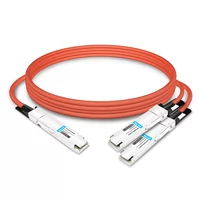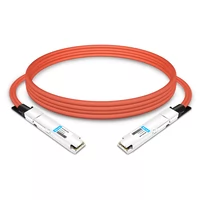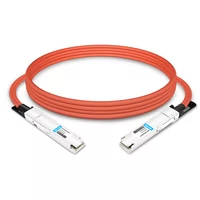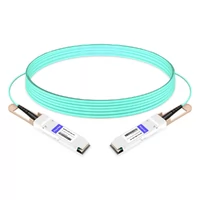The Ultra Ethernet Consortium (UEC) was officially established on July 19, 2023. It is a new organization sponsored by the Linux Foundation and its Joint Development Foundation. UEC aims to go beyond existing Ethernet capabilities such as Remote Direct Memory Access (RDMA) and RDMA over Converged Ethernet (RoCE) to provide a high-performance, distributed and lossless transport layer optimized for high-performance computing and artificial intelligence. It takes direct aim at its rival’s transmission protocol InfiniBand.
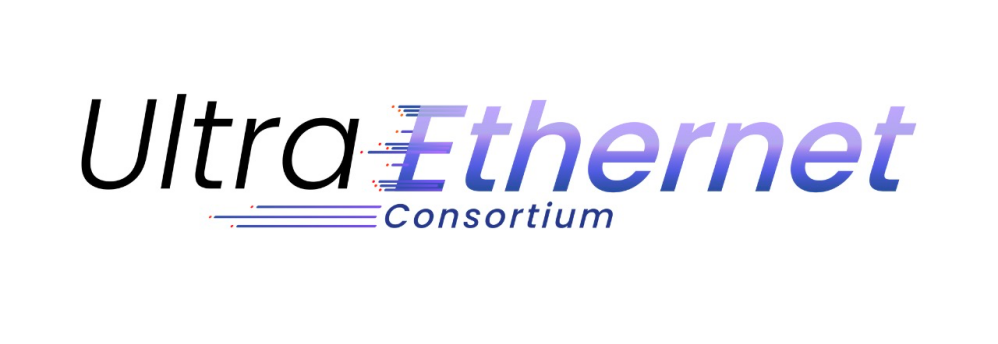
Ultra Ethernet Consortium
UEC’s founding members include AMD, Arista, Broadcom, Cisco, Eviden, HPE, Intel, Meta and Microsoft, all with decades of experience in large-scale deployment of networking, artificial intelligence, cloud and high-performance computing.
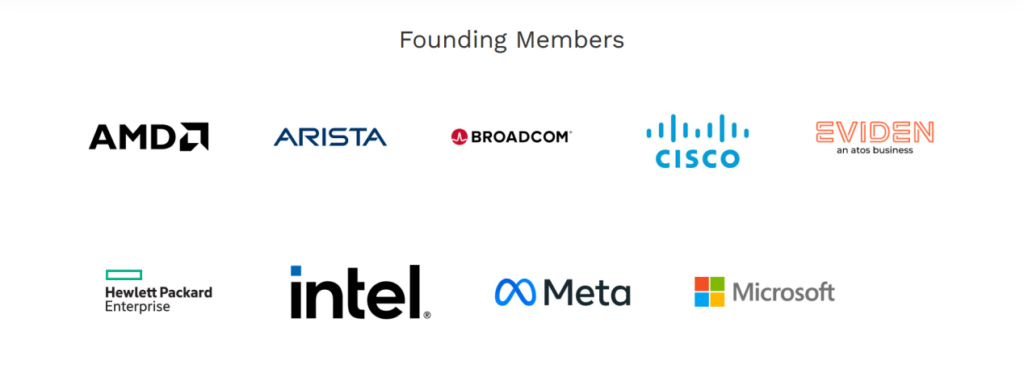
Founding members
Table of Contents
ToggleWhy does Ethernet need UEC?
How is UEC different from the current Ethernet?
Artificial intelligence and high-performance computing bring new challenges to networks, such as the need for greater scale, higher bandwidth density, multipath, rapid response to congestion, and interdependence on the execution of individual data flows (where tail latency is a key point to consider). The UEC specification is designed to bridge these gaps and provide larger scale networking required for these workloads. UEC targets a complete communications stack that solves technical problems across multiple protocol layers and provides functionality that is easy to configure and manage.
How is UEC different from other current protocols?
Existing protocols may address some aspects of the above problems (such as legacy congestion management), but since they are designed for general networks, they lack features critical to artificial intelligence and high-performance computing, such as multipath and easy configuration. Existing protocols may also be vulnerable in relevant scenarios. With UEC members’ rich experience in deploying artificial intelligence and in high-performance computing workloads, UEC will deliver a compelling and comprehensive solution that brings new hardware and software products unavailable with Ethernet or any other network technology today.
What does UEC Plan to Do?
UEC will provide an open, interoperable, high-performance full communications stack architecture based on Ethernet to meet the growing network needs of large-scale artificial intelligence and high-performance computing. From the physical layer to the software layer, UEC plans to make changes to multiple layers of the Ethernet stack. “This is not about revolutionizing Ethernet,” said UEC President Dr. J Metz. “It’s about tuning Ethernet to make it more efficient for workloads with specific performance requirements. We’re looking at every layer from physical to software to find the best ways to improve efficiency and performance at scale.” Metz noted that there is no shortage of network standards and organizations for Ethernet today, and while the IEEE has taken a major role, the UEC focuses on more than the physical transport layer that the IEEE typically focuses on. The UEC’s goal is to study all the elements needed to improve Ethernet and then work with relevant standardization organizations and technical groups to implement these improvements. The Consortium will work to maintain and promote Ethernet interoperability while minimizing changes to the communications stack. The technical goal of UEC is to develop specifications, APIs, and source code to define:
- Protocols, electrical and optical signal characteristics, application program interfaces/data structures for Ethernet communications.
- Link-level and end-to-end network transport protocols that extend or replace existing link and transport protocols.
- Link-level and end-to-end congestion, telemetry, and signaling mechanisms, are all suitable for artificial intelligence, machine learning, and high-performance computing environments.
- Software, storage, management, and security architecture to support a variety of workloads and operating environments.
RDMA vs. UEC Transmission
To improve Ethernet, the UEC proposed the UEC transmission protocol. Metz said UEC transport is being developed to provide better Ethernet transport than current RDMA (which still supports RDMA), retaining the advantages of Ethernet/IP while delivering the performance required for AI and HPC applications. UEC transport is a new form close to the transport layer with some semantic tuning and congestion notification protocol and enhanced security features. UEC will provide more flexible transport that does not require lossless networking, allowing features such as multipath and out-of-order packet transport required for many-to-many AI workloads. UEC transmission protocol:
- An open protocol specification designed from the ground up to run on IP and Ethernet
- With multipath, packet spray transmission, fully utilizing the AI network without causing congestion or head-of-line blocking, without the need for centralized load balancing algorithms and routing controllers
- Incast management mechanism to control fan-in on the final link to the target host with minimal packet loss
- Efficient rate control algorithm allows transmission to quickly increase to line speed without incurring the performance loss of competing streams
- API for out-of-order packet delivery with the option to complete messages in order, maximizing network and application concurrency and minimizing message latency
- Scalable future network supporting 1,000,000 endpoints
- Performance and optimal network utilization without the need for network – and workload-specific tuning of congestion algorithm parameters
- Designed to enable wire-rate performance for 800G, 1.6T and future faster Ethernet on commodity hardware
Key Benefits of Ultra Ethernet for Modern Applications
To optimize for search engines and provide deeper insights, we’ve expanded this article with a dedicated section on the benefits of ultra Ethernet. These advantages make ultra Ethernet a preferred choice for organizations building next-generation data centers.
- Scalability for Large-Scale Deployments: Ultra Ethernet supports networks with up to 1,000,000 endpoints, eliminating the need for workload-specific tuning of congestion algorithms. This scalability is essential for AI training farms and HPC clusters handling petabytes of data.
- Improved Performance Metrics: With features like low tail latency and high bandwidth density, ultra Ethernet delivers superior throughput compared to traditional Ethernet. For instance, it enables efficient handling of 1.6T Ethernet speeds, reducing bottlenecks in real-time AI inference.
- Cost-Effectiveness and Interoperability: By building on existing Ethernet infrastructure, ultra Ethernet reduces deployment costs while ensuring compatibility with legacy systems. Founding members like AMD, Intel, and Microsoft emphasize its open-source approach, fostering innovation without vendor lock-in.
- Enhanced Security and Reliability: Ultra Ethernet incorporates advanced telemetry for proactive congestion management, minimizing packet loss and enhancing data integrity in mission-critical environments.
These benefits position ultra ethernet as a future-proof solution, driving adoption in cloud computing, machine learning, and scientific research.
Ultra Ethernet vs. Competing Technologies
For better SEO and comprehensive coverage, we’ve added a comparison table to highlight how ultra Ethernet stacks up against alternatives like InfiniBand and standard Ethernet.
| Feature | Ultra Ethernet (UEC) | InfiniBand | Standard Ethernet (RDMA/RoCE) |
|---|---|---|---|
| Bandwidth Support | Up to 1.6T and beyond | Up to 400G (HDR) | Up to 400G |
| Latency | Low tail latency with multipath | Ultra-low latency | Moderate latency |
| Scalability | 1,000,000+ endpoints | High, but hardware-dependent | Limited by congestion |
| Cost | Lower (commodity hardware) | Higher (specialized hardware) | Moderate |
| Interoperability | High (open Ethernet standards) | Moderate (proprietary) | High |
| Best For | AI/HPC with flexible workloads | HPC with strict low-latency needs | General-purpose networking |
This comparison underscores why ultra ethernet is gaining traction as a versatile alternative for AI-driven industries.
The Road Ahead for UEC
Looking ahead, the workloads and networking needs of AI and high-performance computing are expected to overlap increasingly. Taking into account the different sensitivities to bandwidth and latency, the UEC specification will provide two profiles – one optimized for AI and the other optimized for HPC.
Ensuring interoperability through plug-in testing and compliance testing will be a future focus, said Uri Elzur, Chairman of the UEC Technical Advisory Committee. UEC’s goal is to ensure its openness and interoperability. The UEC draft specification will be released soon and be open for use.
Future Trends in Ultra Ethernet
Looking forward, ultra Ethernet is poised to shape the networking landscape. Emerging trends include:
- Integration with AI Accelerators: Partnerships with companies like NVIDIA could see ultra Ethernet embedded in GPU clusters for faster model training.
- Sustainability Focus: Energy-efficient designs in ultra ethernet will help reduce the carbon footprint of data centers.
- Adoption in Edge Computing: As IoT and 5G expand, ultra Ethernet could enable ultra-fast data processing at the edge.
These trends highlight the long-term potential of ultra Ethernet in transforming digital infrastructure.
Common Questions About Ultra Ethernet
What is Ultra Ethernet?
Ultra Ethernet refers to the enhanced Ethernet technology developed by the Ultra Ethernet Consortium (UEC), designed for high-performance AI and HPC applications.
How does ultra Ethernet improve upon traditional Ethernet?
Ultra Ethernet adds features like multipath routing and congestion control, enabling better scalability and performance for data-heavy workloads.
Who are the key members of the Ultra Ethernet Consortium?
Founding members include AMD, Arista, Broadcom, Cisco, Eviden, HPE, Intel, Meta, and Microsoft.
Is Ultra Ethernet compatible with existing networks?
Yes, ultra Ethernet maintains interoperability with standard Ethernet, minimizing changes to existing stacks.
When will Ultra Ethernet specifications be available?
Draft specifications are expected soon, with ongoing development for AI and HPC profiles.
Related Products:
-
 NVIDIA MCA7J60-N004 Compatible 4m (13ft) 800G Twin-port OSFP to 2x400G OSFP InfiniBand NDR Breakout Active Copper Cable
$800.00
NVIDIA MCA7J60-N004 Compatible 4m (13ft) 800G Twin-port OSFP to 2x400G OSFP InfiniBand NDR Breakout Active Copper Cable
$800.00
-
 NVIDIA MCA4J80-N004 Compatible 4m (13ft) 800G Twin-port 2x400G OSFP to 2x400G OSFP InfiniBand NDR Active Copper Cable
$650.00
NVIDIA MCA4J80-N004 Compatible 4m (13ft) 800G Twin-port 2x400G OSFP to 2x400G OSFP InfiniBand NDR Active Copper Cable
$650.00
-
 NVIDIA MCA4J80-N003-FTF Compatible 3m (10ft) 800G Twin-port 2x400G OSFP to 2x400G OSFP InfiniBand NDR Active Copper Cable, Flat top on one end and Finned top on other
$600.00
NVIDIA MCA4J80-N003-FTF Compatible 3m (10ft) 800G Twin-port 2x400G OSFP to 2x400G OSFP InfiniBand NDR Active Copper Cable, Flat top on one end and Finned top on other
$600.00
-
 NVIDIA MFS1S00-H005V Compatible 5m (16ft) 200G InfiniBand HDR QSFP56 to QSFP56 Active Optical Cable
$355.00
NVIDIA MFS1S00-H005V Compatible 5m (16ft) 200G InfiniBand HDR QSFP56 to QSFP56 Active Optical Cable
$355.00

